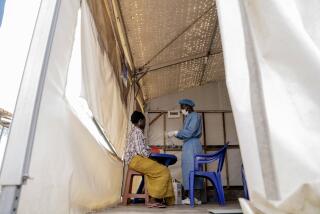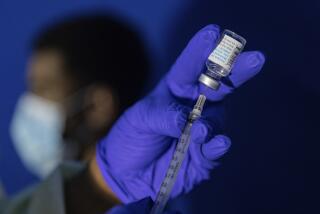Smallpox Ravaged World for Eons
In a Cairo museum lies the 3,000-year-old mummy of an Egyptian king, his leathery face pocked and pitted from the ancient and deadly enemy that took his life.
The mummy is one of the earliest-known victims of smallpox -- a tiny virus that none of us encounters today but was, until recently, an ever-lurking threat that claimed countless souls, slaying emperors and queens as freely as it struck down beggars and peasants.
Today the smallpox virus has been routed, pushed to the brink of extinction by a huge international effort involving worldwide vaccinations. The last-known natural case was in 1977 in Somalia.
“This is, along with safe drinking water, the greatest public health success of the 20th century,” said Dr. David Pegues, associate professor and hospital epidemiologist at UCLA.
The prospect that anyone would try to once again unleash this scourge on the world through biowarfare is thus more than horrible; it is horribly ironic.
This is a virus that had ravaged humankind for as long as 10,000 years, causing empires to collapse, destroying whole peoples and transforming the smooth, fresh faces of survivors into grotesque reliefs of craters and bumps.
An epidemic in AD 180 killed as many as 7 million in Italy, Greece, Egypt and Asia Minor, possibly triggering the decline of the Roman Empire.
The inadvertent introduction of smallpox into the Americas by the Spanish killed millions of Aztecs, helping a few hundred conquistadors conquer an entire people.
Millions more North American Indians died, some at the hands of the British, who deliberately gave them gifts of blankets infested with smallpox scabs during the French and Indian Wars.
Only 40 years ago, 10 million to 15 million people worldwide contracted smallpox annually and 2 million of them died.
Yet through these centuries of horror came a slow, dawning knowledge -- and human beings began to fight back.
It had long been noted, for instance, that survivors were thereafter immune to the disease. Centuries ago, people translated this fact into a logical, if hazardous practice known as “variolation,” the first inoculation against an infectious disease.
An incision was made in the skin. Then, matter from a pustule or scab from a mild, smallpox case would be placed in the incision, exposing the body to a low-grade smallpox infection.
In England, variolation was introduced by Lady Mary Wortley Montague, whose face had been permanently scarred by “the speckled monster.” She had seen old women performing the procedure in Turkey, and pressed for its introduction in England. (British authorities first tested the method on condemned prisoners and pauper children.)
Variolation also came to Colonial America. Puritan Cotton Mather learned of the technique from an African slave. Mather strongly advocated the practice, which was considered ungodly by many, who believed it interfered with God’s will. One protester firebombed Mather’s house, leaving a note: “COTTON MATHER, you Dog ... I’l[l] inoculate you with this, with a Pox to you.”
Variolation was risky, killing 1% to 3% of the people who tried it. But this was better than risking a natural infection, which killed 20% to 30%. After his troops were devastated by smallpox early in the American Revolution, Gen. George Washington ordered the variolation of his troops.
But there was another problem with variolation: It spread disease.
“It was really as likely to start an epidemic as it was to stop one, unless it was administered under a very strict quarantine,” said Elizabeth Fenn, author of the book “Pox Americana” and an assistant professor of history at Duke University in Durham, N.C.
Quarantine was not the rule: Abigail Adams, for instance, wrote a series of cheerful letters to her patriot husband, John Adams, after her variolation, describing her attendance at sermons, public meetings and standing with “the multitude” to hear the reading of the Declaration of Independence.
“I read this and I just cringed,” Fenn said.
It wasn’t until the end of the 18th century before a safe vaccine was developed, a pivotal discovery rooted in the oft-repeated lore that milkmaids had fresh, smooth complexions because they never got smallpox, just a mild infection from cows known as cowpox.
Edward Jenner, an English scientist, first heard this tale as a teenager. Years later, after penning many scholarly treatises on such subjects as the natural history of cuckoos, he decided to tackle the smallpox and cowpox connection.
In a key 1796 experiment, Jenner showed that a child inoculated with cowpox pustule extract no longer reacted when variolated with smallpox, implying the child was now immune to smallpox. His work was considered preposterous by the scientific community and he was forced to finance its publication himself.
But as other scientists confirmed Jenner’s work, the huge significance of his discovery became clear, and the practice of vaccination, from vaccine, which come from the Latin word for cow, swept through the world. Jenner was proclaimed a hero. Even Napoleon said he could refuse Jenner nothing, releasing prisoners upon his request during wars between France and England.
To get live vaccine safely to the Americas, the Spaniards loaded 22 orphan children into a ship and sequentially infected their arms with the virus so that there was still fresh, living material by journey’s end.
Vaccination works because the virus used, the vaccinia virus, is similar enough to the smallpox virus to confer immunity. In 1967, the World Health Organization embarked on a worldwide eradication program based on mass vaccination with vaccinia -- and by 1980, it appeared that their job was complete.
*
(BEGIN TEXT OF INFOBOX)
Disease history
AD 900: Persian physician records the first clear account of smallpox.
1507: First case of smallpox in the Western Hemisphere occurs on the Caribbean island of Hispaniola.
1617-1619: First epidemic in North America.
1796: First clinical inoculation takes place.
1855: Massachusetts is the first state to pass a mandatory school vaccination law.
1925: 43,000 cases are reported in the United States.
1949: Last case in United States occurs in the lower Rio Grande River Valley of Texas.
1967: World Health Organization begins global eradication program.
1972: Routine immunization ends in the United States.
1977: Last case of naturally occurring smallpox is recorded in Somalia.
1980: The disease is declared eradicated. Most vaccine production facilities are closed.
*
Source: Centers for Disease Control and Prevention
More to Read
Sign up for Essential California
The most important California stories and recommendations in your inbox every morning.
You may occasionally receive promotional content from the Los Angeles Times.








